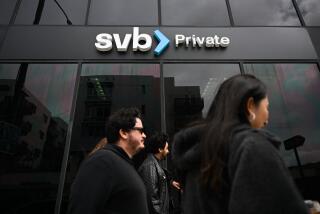FDIC Makes It Easier to Check Banks’ Health
- Share via
More banks failed in 1987 than in any year since the Great Depression. And the collapse of dozens of thrifts forced Congress last year to bail out the insolvent Federal Savings and Loan Insurance Corp.
With many savings institutions teetering in such a fragile state, it’s understandable if you want to know more about the financial condition of your bank or savings and loan. You may be worried about the reliability of federal deposit insurance or the hassle of getting your money out if a bank fails. Or you might be shopping for high savings rates--and know that high-rate institutions often are financially troubled and need to pay more to attract deposits.
Fortunately, access to financial information about savings institutions is getting easier.
The Federal Deposit Insurance Corp. last month adopted a rule requiring the 8,500 banks it supervises to provide annual financial disclosure statements to consumers upon request by March 31 for year-end 1987 data. The banks may provide these statements at their branches or by mail from central locations. The statements also can include additional discussion and analysis to explain the often arcane figures.
The FDIC, on a case-by-case basis, also will require that certain banks disclose descriptions of regulatory enforcement actions that have been taken against them.
The rule should greatly reduce the time and hassle of obtaining information about banks. Consumers in the past had to write to the FDIC for this information; they still can, but that may take longer.
The Comptroller of the Currency and the Federal Reserve are expected to adopt similar rules governing banks they supervise, thus extending the requirement to all of the nation’s 13,900 banks.
No such requirement has been adopted for the nation’s 3,200 S&Ls;, which are regulated by the Federal Home Loan Bank Board. But quarterly reports on individual S&Ls; are available by writing to the bank board’s Office of Policy and Economic R e search, 1700 G St. N.W., Washington, D.C. 20552. They will bill you between $2 and $3 per report, depending on the number of pages.
If you want to compare your bank with others or obtain data going back several years, then a good source is the Uniform Bank Performance Reports available from the Federal Financial Institutions Examinations Council. This organization converts financial statistics into various ratios and compares those ratios to other banks of similar size for as far back as five years.
The 20-page reports, available for banks but not S&Ls;, cost $30 each and can be obtained by writing UBPR, Dept. 4320, Chicago, Ill. 60673, with a check payable to the council. To help you understand the ratios, you also can order the council’s $15 Users Guide. Order sheets for the reports can be obtained by writing the council at 1776 G St. N.W., Suite 701, Washington, D.C. 20006.
But such information, while useful, is no panacea. You still need to understand it, and most ordinary consumers cannot read simple financial statements, much less the complicated ones issued by banks. Many of these reports are written for regulators, fellow bankers and sophisticated financial analysts.
“The information can be mumbo jumbo to the average consumer,” said Robert K. Heady, publisher of Bank Rate Monitor, a North Palm Beach, Fla., newsletter.
Way to Measure
“If you don’t know what to look for, it’s going to be tough,” said Ellen Stockdale, spokeswoman for the office of the Comptroller of the Currency.
Any of a number of measures can be used to judge an institution’s strength, but one of the best is its equity-to-assets ratio. That shows the bank’s equity capital as a percentage of its loans and other assets. Most analysts agree that 5% is a traditional minimum for larger banks and S&Ls;, 6% or above for smaller institutions.
Another good measure is earnings as a percentage of assets, otherwise called return on assets; 1% or more generally is good, although only about half of the nation’s banks and one-fourth of S&Ls; meet that level, according to Warren G. Heller, research director for Veribanc, a Massachusetts firm that tracks such data.
Bank Rate Monitor’s Heady suggests using your accountant or financial planner to help you decipher the mumbo jumbo. Heady also offers a 36-page booklet, “How Safe Is Your Money?,” which describes how to check the financial condition of an institution, how federal deposit insurance works and how to do business with an out-of-state bank. It’s available for $2.50 from 100 Highest Yields, P.O. Box 088888, North Palm Beach, Fla. 33408.
For a fee, several private firms also will help you decipher bank statements. For $20 each, Veribanc (Box 2963, Woburn, Mass. 01888; 617-245-8370) will provide reports on individual banks, S&Ls; or credit unions, summarizing data on their equity capital, earnings and problem loans and assigning each a color code of green, yellow or red. Green banks (currently 11,277 nationwide) are considered to be stronger, red banks (539) considered to be weaker and yellows (2,079) are in between.
For $30 each, Veribanc will provide a list of the 40 largest green-coded banks in California or another state or region, along with banks in that area with a blue rating--given to the banks that Veribanc considers the financially strongest.
Another service is provided by Sheshunoff & Co. (P.O. Box 13203, Capitol Station, Austin, Tex. 78711; 512-472-2244). For $25 each, it will provide six-page rating reports on individual banks or S&Ls;, covering their five-year operating history, with graphs illustrating deposit growth, income, loan quality and other measures.
Big Banks May Be Safest
For $65 each, Sheshunoff will provide its bank quarterly report. It compares each of the nation’s banks to institutions of similar size and includes a one-line summary of financial data for each bank. A similar quarterly is available for S&Ls.; If that is too expensive, those reports are available in some larger libraries.
More expensive and detailed reports--largely geared toward institutions rather than individuals--are available from several other sources. Cates Consulting Analysts, for example, provides reports on individual institutions for $100 (40 Broad St., New York, N.Y. 10004; 212-968-9200).
Is the cost of these and other reports worth it to the average depositor?
Probably not if you make sure you deposit your savings only in federally insured institutions and never put more than $100,000 into any one. Since the founding of the FDIC and FSLIC, no one has ever lost a penny in a federally insured account under the $100,000 limit per depositor per institution. If anyone ever does, it would probably coincide with a major collapse of the U.S. government and financial system--not a likely scenario.
Also, the nation’s 20 or so largest banks and S&Ls--most; of which don’t make the lists of the financially strongest--are considered to be failure proof simply because the federal government cannot afford to let them fail. The failure of a bank the size of a Bank of America or an S&L; the size of American Savings could trigger a major financial crisis, which Uncle Sam would take every step to avoid. Thus, big banks or S&Ls; may be among the safest to put your money in--even if they don’t make the lists of strongest banks.
Bank failures can, however, result in the hassles of standing in line or sending in requests by mail to retrieve deposits. But in most bank failures, depositors don’t need to do anything, because failed institutions are usually merged into stronger institutions that assume all deposits and loans. Or accounts are transferred to another, stronger institution.
The greatest hassle may involve loans with failed institutions. A new bank acquiring a loan from a failed institution may try to call in the loan or change its terms, if that is allowed under the loan contract. Or the loan may be kept or sold to the FDIC or FSLIC, which could give the borrower less flexibility in refinancing it or obtaining more credit.
More to Read
Inside the business of entertainment
The Wide Shot brings you news, analysis and insights on everything from streaming wars to production — and what it all means for the future.
You may occasionally receive promotional content from the Los Angeles Times.










